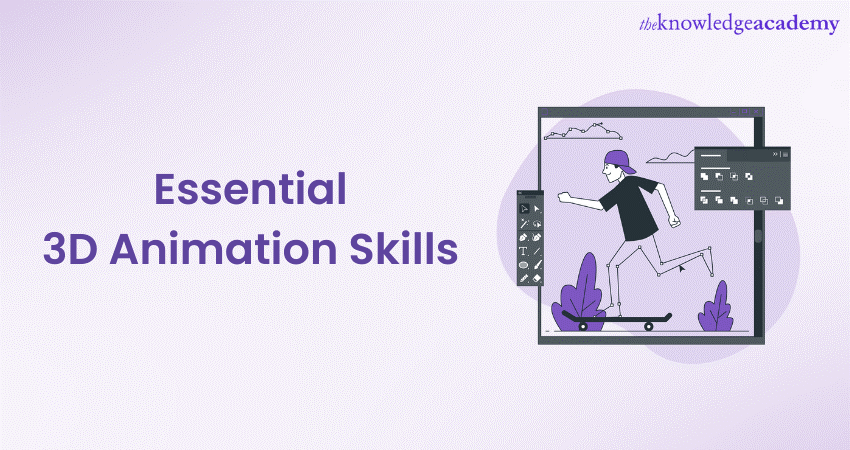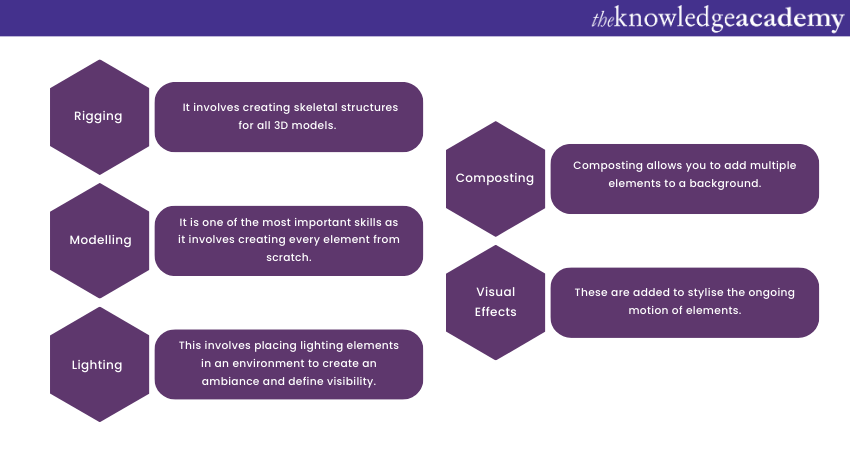We may not have the course you’re looking for. If you enquire or give us a call on +55 8000201623 and speak to our training experts, we may still be able to help with your training requirements.
We ensure quality, budget-alignment, and timely delivery by our expert instructors.

The world of 3D Animation is vast; from movies to video games, you’ll come across stellar examples from the domain. For obvious reasons, one needs to know the intricacies involved with 3D Animation if one want to try their hands on the craft. This can only be done by getting in touch with the right 3D Animation Skills. This blog shall guide you through the basics of 3D Animation, followed by the skills required to get started in today’s world.
Table of Contents
1) What is 3D Animation?
2) Tools used to create 3D Animations
3) What are the necessary 3D Animation Skills that an Animator should know?
4) Conclusion
What is 3D Animation?
Three-Dimensional Animation or 3D Animation is a digital technique that involves creating moving images and visual effects. It is a step up from 2D Animation as it uses three axes rather than the conventional X and Y axes. A professional in charge of creating 3D Animations is referred to as a 3D Animator. There are a number of studios that deploy 3D Animators to create works of art. It is a collaborative process, as a lot of artistic input and technical know-how are required.
Enhance your marketing techniques with animated, engaging posts, establish a strong online presence and get ahead of the curve with Animation and Design Training.
Tools used to create 3D Animations
The deployment of a 3D Animator’s Skills is done through various tools. These tools aid a 3D Animator in performing rendering, rigging, animating, and a lot more. Here’s a list of commonly available tools that professionals prefer:
1) Blender: This tool is quite popular among both learning stages, i.e., the beginner and the professional. It is a free-to-use, open-source tool that helps with animation, sculpting, rendering, and a lot more.
2) Autodesk Maya: Autodesk Maya is considered to be one of the best tools that an Animator can learn. Its applications involve the creation of assets for popular media representations such as movies and TV shows.
3) Unity: This tool is highly popular among Video Game Development studios. Its ability to combine multiple assets for a cohesive experience makes it a primary choice for game developers. It is highly used to create real-time 3D applications, games and 3D simulations.
4) Unreal Engine: Another viable tool used for Video Game Development is the Unreal Engine. Upon deploying your 3D Animation Skills, you can create interactive animations, technology demonstrations, and in-game assets.
5) Houdini: Houdini is a potent tool that gives you the ability to perform procedural generation. Commonly used in filmmaking and Video Game Development, Houdini is favoured because of its node-based workflow.
Want to commence your own creative project but don’t know where to start learning for it? Check out the Blender 3D Modeling For Unity Training.
What are the necessary 3D Animation Skills that an Animator should know?
Now that you’ve seen the list of tools necessary to get the job done let’s take a closer look at the skills needed. While the roster for 3D Animator Skills is huge, you can start your animation journey with the following skills. Bear in mind that proficiency in the aforementioned tools also acts as a skill, and you can combine tool proficiency with specific skills. Below are a list of skills you can learn to commence your animation journey:

1) Rigging: Rigging happens to be one of the most important skills that an Animator should know. It involves creating a skeletal structure that works well with the environment in which an element is placed. Deformities are studied and refined to improve the realistic quotient of an element. Damage models use rigging as it helps collect impact data and create better and more realistic models.
2) Modelling: As the name suggests, modelling involves creating 3D models of different objects that can be placed in an environment. It is one key skill that every Animator should know. For obvious reasons, it is different from 2D modelling as you lose the Z axis and the field of depth.
3) Lighting: What use is an object if you can’t see it in an environment? Lighting is a key element in 3D Animation that uses light sources to illuminate elements and the surrounding areas. Different lighting elements give varied illumination zones. For example, a point source can scatter light everywhere, while a conical one will illuminate the area in a cone.
4) Composting: When you combine two or more elements to create a bigger picture, that’s composting. This skill allows you to add elements to a background or add characters and special effects to a background. It can also be used to correct alignment, perspective and remove elements if needed.
5) Visual Effects: You must’ve seen movies where magicians cast spells, vehicles explode, or dinosaurs chase people, that’s nothing but visual effects. Anything that is artificially added to a scene to make it look better by using 3D animation is a visual effect. Their usage becomes essential in places where an impact or a spectacle is supposed to be added. Video games use a ton of visual effects to enhance players’ actions and create a fun gameplay loop.
The aforementioned skills are of a technical nature and can be learned through practice. However, there are a few more skills that require a human touch; they’re independent of tool usage or any technology in general. These are:
1) Creativity: Perhaps one of the most important 3D Animation Skills that an Animator should possess, creativity is a must-have in 3D Animation. An Animator should be able to brainstorm ideas and transform them into reality. At times the most creative works of art generate the strongest of emotions.
2) Teamwork: As cliché, as it sounds, this skill is of paramount importance for an animator. As mentioned earlier, 3D Animation requires a lot of people to come up with ideas. It often requires the collaboration of multiple artists and artworks to create a unique work of art. If you’re willing to collaborate with different people and exchange ideas, chances are that the end result will be a unique one.
3) Attention to detail: Another key skill that an Animator should be equipped with is their ability to have an eye for detail. A lot of elements might skip the general viewer, which can be crucial. An Animator, however, is supposed to look for elements that can make the experience even better. Minor improvements, when done, can improve the overall experience quite significantly.
4) Having an unorthodox approach: The conventional way of designing things, while feasible, often falls into an endless cycle of mediocrity. This is where an Animator’s creative muscles can be flexed to break the cycle. An Animator should be able to think outside the box at times while solving a problem. A lot of artists and designers often fall prey to mediocrity; it only ends when they take a totally different approach. And it shows when movies or video games do it. People love to witness something that they can’t explain.
Conclusion
From movies like Toy Story, Wall-E, and Shrek to videogame franchises like Call of Duty, Need For Speed, and Elder Scrolls, 3D Animation is everywhere. The level of complexity these days has made it hard for the naked eye to tell the difference between computer-generated and natural elements. AI Animation Generators are revolutionizing the 3D animation space by allowing creators to generate realistic and immersive animations quickly. 3D Animation Skills are a must-have if you’re looking to get started with any of the tools mentioned above, and leveraging AI Animation Generators will give you an edge in creating high-quality content.
Looking for a way to step up from 2D animation to 3D animation? Here’s the Blender Creator Training to help you.
Frequently Asked Questions
Upcoming Office Applications Resources Batches & Dates
Date
 Blender 3D Modeling for Unity Course
Blender 3D Modeling for Unity Course
Fri 21st Feb 2025
Fri 4th Apr 2025
Fri 6th Jun 2025
Fri 25th Jul 2025
Fri 7th Nov 2025
Fri 26th Dec 2025






 Top Rated Course
Top Rated Course



 If you wish to make any changes to your course, please
If you wish to make any changes to your course, please


